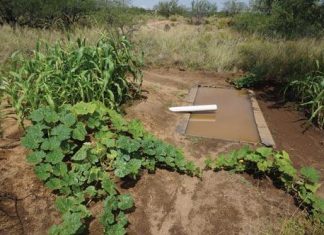 |
|
| Issue #48 • November/December, 1997 |
It is our job to maintain two and one half miles of dirt road if we want to get into our property. We are completely surrounded by forest service land, and we have an agreement with the forest service to maintain one mile of the road. However, when we reminded the forest service the other mile and a half needed maintenance, too, they answered us in a tone that brooked of no appeal: “We don’t like you living in the middle of the forest; you are the only family at the end of that road; it costs us too much to maintain that road for one family; therefore, it is up to you to keep that road open. We call it your road anyway.”
So, “our road” it has become. And maintaining it has been an adventure. In fact, working the road led our family into a chain of events we could never have foreseen, not even with the help of a crystal ball gazer. (See Issue 30, “David and the D-4”).

Hubert Burris on a Ford 2000 tractor with blade attached |
In our 25 years of maintaining a dirt road, we have found that, whether you use hand tools or heavy machinery, there are three main objectives: control the flow of water around the road, remove obstacles, and fill in the rutsusually in that order.
Control the flow of water
Water in any of its formssnow, ice, sleet, or rainis your number one enemy when you maintain a dirt road. When it is raining, observe your road closely. Water run-off takes the line of least resistance, and you can tell what you need to do to control the flow and where your efforts will produce the most results if you know the path the water naturally takes around or over your road. You can also tell where water will puddle and stand in the driving lanes. If water stands in a low spot, you know snow will collect there too. And standing snow will freeze and thaw, making a bog, one of the worst situations in a dirt road.
The first step to drain water away from a road is to slope the road bed slightly from side to side. Some people “crown” a road, that is, they make the center of the road bed higher than the sides letting the water drain from the middle of the road to either side. We have found making a crown hard to do, especially on the steep grades of our mountainous road. In fact, when we agreed with the forest service to maintain our road, they gave us pages and pages of instructions for minimum standards for a single lane fair weather road, and they recommended the side to side slope drainage. Their recommendations call for an outslope of one-fourth inch per foot of road width. At this rate a thirty foot wide road would be seven and one half inches higher on the high side than on the low side. This doesn’t look or feel like much slope when you drive down the road, but it is enough to force the water to run off the side instead of following the road bed down the grade and cutting ruts. (See Figure 1)

Outslope and ditch |
If you can slope the road toward the outside edge of a road bank and let the water run off down the side of the hill, your work is done. But there are times when the contour of the land makes it necessary to contain and direct water away from the road by means of a ditch along the side of the road. The bank of the ditch from the edge of the road to the bottom of the ditch needs to slope at an angle of no less than three inches in a foot. (See Figure 1)
This prevents the water from flowing back onto the road. An adequate ditch needs to be at least one foot wide and one foot deep. In very heavy run off areas, a ditch might need to be much larger. By watching your road during a rain storm, you can estimate just how large a ditch you need in a given area.
At some point, either the water in the ditch, or water rushing down the side of a hill in a wash, will need to be directed across the road. A culvert is ideal here, but culverts are expensive and usually take a lot of work to install. An easier way to direct the water across the road is with what the forest service calls a “grade dip.” Our family calls it a speed bump because it feels somewhat like a speed bump in a shopping center parking lot when you drive over it. A grade dip is essentially a shallow ditch dug across the road and lined with rock. The dirt dug out of the ditch is mounded across the road on the downgrade side, making a bump which blocks the water from running down the road and making it flow off the road through the rock-lined ditch.

Grade dip |
A good grade dip will be at least 70 feet wide, counting the width of both the ditch and the mound. The ditch part should be about 50 feet wide; the mound should be at least 20 feet wide and have a rise of at least 30 degreesbut 45 degrees is preferable. (See Figure 2) If the uphill grade of the road is steeper than five percent, the grade dip should be widened five feet for each one percent of grade rise. For example, a road having a grade rise of 6 percent should have a grade dip 55 feet wide; a road with a 7 percent grade rise should have a grade dip 60 feet wide. We’ve maintained some grade dips on our road for at least 20 years, and they continue to be very effective.
In low areas where water puddles or snow collects, a simple turnout might be all that is needed to drain the road. A turnout is a shallow notch dug into the outslope edge of the road which encourages the water to flow away. (See Figure 3) Turnouts sometimes need to be lined with rock so they don’t cause the edge of the road to erode.
Remove obstacles
It seems like there’s always something in the way on a dirt road in the backwoods. After a big rain, snow, or wind storm, our first question is, “Is our road open?” We are prepared with food and emergency supplies to be stranded for several weeks at a time, and most winter seasons there are at least a few days when we are not able to get out of our homestead. We’ve learned to wait until a deep snow melts enough for us to safely clear the road, and for the road to dry some after a downpour before trying to travel it. We scooted our crawler tractor over the edge of a sharp turn once when we were trying to clear a 30-inch snow from the road in order to get out in a hurry. We slid the Ford tractor over the edge three times and our little Toyota truck has gone over once. We’ve been lucky, as none of our vehicles have turned over, and we have been able to haul them back up with lots of hard work. Figuring that some day our luck might run out, we have finally learned to be prudent and just wait awhile before trying to get out of here. It is a lot more comfortable to stay in the house with a cup of hot cocoa and a good book than it is to risk your neck out in the wet and cold, huffing and puffing with pulleys and cables, trying to undo something that needn’t have happened in the first place.
However, there are times when some things just have to be removed from the road. One ongoing nuisance for us is the huge rocks that keep heaving up in our road bed. The first method of attack is to dig them out. We outline the rock with pick and shovel to see just how big it is, dig down a way all around the rock, then try to slip a chain or cable on it and pull it out with a vehicle. I don’t even want to guess how many rocks we’ve gotten rid of this way.

A turnout for draining water off the road |
Then there are the boulders that are just too big to dig out. We’ve used “poor man’s dynamite” many, many times. That’s when you heat a rock as hot as you can get it, then dump cold water on it. The sudden change in temperature causes the rock to split and shatter. If the rock is small enough, we heat it with a blow torch. If it is too large to heat with a torch, we make a trench around the rock, then drag brush and downed trees in from the forest and cover the top of the rock with a bonfire. It takes awhile to heat a rock this way, but it is effective. Of course, we can use this method only when there is no fire danger, and someone has to attend the fire at all times. We carry barrels of water in the back of the truck when we want to douse the fire.
We’ve used real dynamite once and that’s enough for us. It didn’t go off when it was supposed to. That was scary. If we have another job that needs real dynamite, we will hire it done. Placing dynamite is an art that is worthy of its cost. We don’t know much about dynamite, but we do know enough to leave it to a professional.
Branches and trees fallen across the road after a wind storm are always a possibility in our area. For several years we attempted to carry a small chain saw in the truck every time we went down the road. Naturally, when we forgot the saw, or didn’t have room to put it in the truck, that’s when we needed it. For a while we tried carrying a two-man cross-cut hand saw, but that was bulky to pack, too, and was hard to use.
Then we read a product review in Backwoods Home written by Don Childers about the Short Kutt Pocket Chain Saw (issue 14, page 61). This is a small chain saw blade about 31 inches long with detachable handles, all of which rolls up and fits into a small can not much larger than a shoe polish tin. And the blade is sharp. It really works. The Air Force uses it in their Survival School. We immediately ordered the handy little gadget and stuck it in the glove compartment. It has helped us clear a path in our road more than once.
Landslides onto the road after a period of wet weather plague us. Half a century ago when our road was built, there were no regulations about how steep a bank could be when a rural road was cut into the side of a hill. Some of our road is cut straight down into the side of the mountain with the bank above it at an angle of 80 to 85 degrees. Today it is recommended to out an angle of about 55 degrees in common soil, up to 65 degrees in hard pan or soft rock and 70 degrees in hard rock. This helps to prevent landslides.
When the steep bank does slide down, we leave as much of it as possible at the base of the cut instead of shoveling all the dirt away. This is gradually building a more gentle slope from the roadway up to the top of the cut. Several places on the road are too narrow to leave all the debris, however, so we have tried to pull some of the dirt down from the top of the bank to work it back farther away from the road. We weren’t very successful, so decided to let nature keep trimming away at the top and we keep shoveling at the bottom. It is a lot of hard work.
Those branches from overhanging trees and shrubs which slap you in the face as you drive by are annoying in the summer time, but they can be downright dangerous in the winter when they are full of snow and ice and block your vision. We make a trim-the-branch run down the road in the fall after the leaves have fallen off the deciduous trees and the sap has gone back down the trunks. By standing in the bed of the truck, we can reach most of the offending slappers and saw them off. We stack the branches in the back of the truck, then take them to a gully where we dump them for erosion control. There they can do some good.
Fill in the ruts
One of the most effective ways to fill in ruts is by dragging something heavy over the road behind a vehicle. A good drag can be made from a log, a railroad tie, or a piece of an iron I-beam. The drag should be as long as your vehicle is wide. Drill a hole in each end of the drag about a foot from the end. Thread one end of a chain in each hole and bolt the chain into place so the drag will not slip up and down the chain. (See Figure 4) Fasten the chain to the vehicle, making one side longer than the other so that the drag follows the vehicle at a slight angle. This helps to maintain the slope in the road which forces water to drain off the road.
We have found that the moisture content of the dirt in the road makes a big difference when using a drag.
Too dry, and the drag just moves a little dust around. Too wet, and the mud rolls up under the drag. The road is about right to work when a hand full of dirt makes a crumbly ball, which is the same test that shows when the garden is right to plow. One pass over the road when it has the right amount of moisture in it is better than five passes over the road when it is either too dry or too wet.

A homemade drag to be used for leveling a road |
Some persistent ruts will need to be filled with rock before they heal. We have found that rocks about the size of two fists make a good base in a rut. After these work into the road during a wet spell, they can be covered with either dirt or smaller rocks. We have lots of rocks so we simply crawl across a field and toss the rock into a trailer, then dump it on the road where needed. Over the years we have eliminated many ruts and boggy places in our road with our rocks. Helps to clear our fields of bothersome rocks too. We often laugh and say we are just moving things around where they need to be to do the most good.
In our opinion, without question, the best piece of equipment to own to maintain a road is a small farm tractor with a blade attachment. This is not a small tractor, sometimes called a garden tractor; it is a farm tractor the size of a Ford 2000. This size tractor has enough power to pull a blade, is comparatively easy to maintain, and will work hard for years, not only on the road but just about everywhere else too.
A four-wheel drive is preferable, but a set of tire chains on the big back wheels makes a two-wheel drive tractor work almost as well in mud, ice, and snow as a four-wheel drive.
One other thing we learned the hard wayto avoid making ruts in a wet road, try to drive on it only when it is frozen. That’s usually between four and nine a.m. in our area, if the road is frozen at all. The less ruts made, the less you have to fill.
Even if it is extra work, we think living out in the boonies at the end of a dirt road is very much worth the effort.
















This was a great read. We live in a similar situation in the Ozark National Forest. Our private road is about a mile long with .6 mile of forestry road leading to it. We call ourselves “the road faries”. The first .6 gets used a fair amount by hikers who know of the beautiful waterfalls and overlooks in the area on forest land.
It may be that the mud needs to be removed, and replaced with a #2 slag to get ahead.
All good advice. We live in Hampshire County, WV. Our lane is uphill and about a quarter of a mile long. It is a blood muddy mess. I had a few tons of rocky shale dumped on it. It is so muddy, though, I can’t really spread it yet. I wonder when the grass and trees start to sprout and suck up some of the moisture. Maybe March? Not sure. Maybe April? I have been trying to run the tractor with my bucket on cold mornings when the road is still fairly firm. The pile blocks the road and I’m desperate to get it spread.